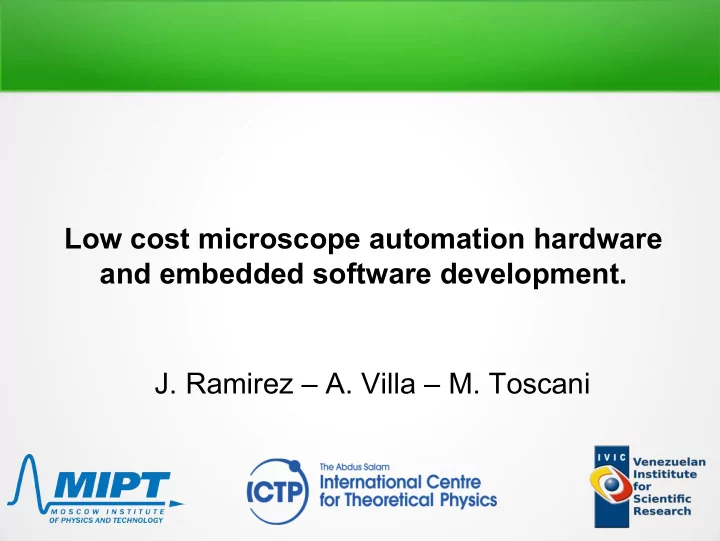

Low cost microscope automation hardware and embedded software development. J. Ramirez – A. Villa – M. Toscani
Introduction What Is this presentation about: ● Provide a general approach for open automation of optical microscopes. ● Low cost hardware and open source software. ● Emphasizing on lowest effort of building and operation.
Introduction Resources: ● Actuators ● Microcontrollers ● Sensors
Introduction What is an Actuator? ● It is a device capable of performing a movement or a mechanical action over another hardware.
Introduction What is a Microcontroller? ● In the most simplified form, it is a whole computer inside of a microchip.
Introduction What is a Sensor? ● Is a device that allows us to measure real world magnitudes by converting them into an electrical signal.
The problem My microscope is perfect without motors. Why are you doing this? ● Manufacturers and their “secrets”. ● Not easily adaptable nor modifiable. ● Software is closed source. (other functions can be added (of course, if the price is right…)
The problem Why is a good idea to have “open” motorized microscopes? Repetitive Instrument tasks Isolation Standard set of Remote ‘peculiar’ additions tend hardware operation to be frowned upon.
The problem Do I need a motorized microscope? ● Functional ● Non functional requirements requirements
The problem
The problem How to face the need of solutions ● Time-of-building vs deadlines. ●Time-of-building vs scientific production increase.
The problem Ok now it has motors. How is it going to be a better tool for me? ● Better than ● Remote commercial operation ● Full device automation ● Complete ● Optimizable for experiment specific app. automation.
The problem Do I need a Mechanical engineer with knowledge in optics and buy a specialized PLC? ● No. Just basic knowledge of gluing some parts together. ● The PLC would be “built”.
Some examples
Some examples
Some examples
The Solution Hardware & Software ● Arduino & Pinguino
The Solution http://www.ryleeisitt.ca/articles/building-a-focus-stackin g-controller/
The Solution Why Arduino & Pinguino?
The Solution Hardware & Software ● Commercial gearboxes
The Solution Hardware & Software ● RC and robotics servos
The Solution Hardware & Software ● Sensors (from old equipment like printers...?)
What about integration?
Embedded Software Development Divide and conquer ● Split the processes in: Functions Actions Hardware Functions Control Stick the hardware method for the to the microscope hardware
Example of Software Development ● Functional requirement: sample plate end stop detection. ● Is an optical switch sufficient: yes (on or off). ● Possible states: 2 (on or off). ● How many inputs do I need: 2 (up-down). ● How to present the data: LCD, or image acquisition PC. ● This action can block (by software) the corresponding motor to protect our microscope.
How to program Students. Graphical ● programming. ● Mature software. Free control libraries.
An application case ● Arduino based laser microlithography platform using low cost hardware.with G code implementation (on development).
Arduino Laser Microlithography platform ● Old microscope: Zeiss IM35 circa 1950. ● Arduino Mega. ● Two LCD screens ● Development PC ● Laser and focusing hardware. ● Two motor gearbox and sensors.
Arduino Laser Microlithography platform
Arduino Laser Microlithography platform
Controller Unit
Project Evolution ● 1. Local heating of a sample by means of a focused laser. ● 2. The team needed a motorized stage. ● 3. The system was converted for lithography. ● 4. The system is going to be used for single cell fluorescence. ● Is capable of “cutting” carbon nanotube fabric electrodes.
Results and comparison ● The system developed performed enough well to be considered a candidate to start the development of an “open source automated patch-clamp system”. ● Tolerance raw data, repetitivity and absolute displacement among coordinates proximately available on request.
Some examples ● Rylee Isitt stacking with arduino ●http://www.ryleeisitt. ca/articles/building-a -focus-stacking-cont roller/
Some examples ● Rylee Isitt stacking with arduino ●http://www.ryleeisitt. ca/articles/building-a -focus-stacking-cont roller/
Some examples ●3D Printed microscope, semi automatic. http://www.instructa bles.com/id/Low-cos t-digital-microscope- with-automated-slide -m/
Some examples A portable low-cost long-term live-cell imaging platform for biomedical research and education http://www.sciencedirect.com/science/article/pii/S0 956566314007489
Disadvantages ● Slow evolution. ● One-of-a-kind parts. ● Software integration difficult (to commercial). ● Multi language programming environments. ● Time of development. ● Device duplication.
Conclusions Learning opportunities. Support and collaboration from communities Better, faster research by less money.
Useful Resources ●Low cost Microscope Automation components: http://www.tofrainc.net/ ●Make your own automated microscopy system: http://users.ox.ac.uk/~atdgroup/technicalnotes/Make%2 0your%20own%20automated%20microscope.pdf ●A portable low-cost long-term live-cell imaging platform for biomedical research and education http://www.sciencedirect.com/science/article/pii/S09565 66314007489
Thank you for your attention. Questions javierramirezbenavides@gmail.com jaramirez@ivic.gob.ve “Computer is not a device anymore, is an extension of your mind, and a gateway to other people” - Mark Shuttleworth.
Recommend
More recommend